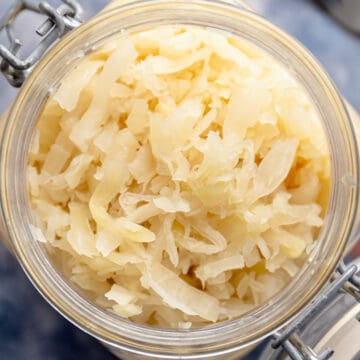
How To Make Easy Canned Sauerkraut
If you’ve never thought about making homemade sauerkraut, this recipe will show you how ridiculously easy it is to make your own in just a few days. With only 2 simple ingredients you'll never go back to grocery store-bought kraut again. Plain cabbage never tasted so good.
INGREDIENTS
- 3 pounds green cabbage
- 1 tablespoon sea salt
- clean glass jar, I used 1 32 ounce jar, about 1 litre
For brine if needed:
- 1 additional tablespoon of salt and 4 cups water
INSTRUCTIONS
- Prep the cabbage. Begin by rinsing the cabbage and discarding any wilted outer leaves of the cabbage.
- Quarter the cabbage by using a sharp knife. Remove the core and then slice the cabbage into thin strips, aiming for approximately ¼ inch in width. It's not essential for the strips to be perfectly uniform. If you prefer you can also use shredded cabbage.
- Transfer the sliced cabbage into a large bowl and evenly sprinkle sea salt over it.
- Mash the cabbage. Now, initiate the mashing process. There's no specific technique; the best way is to just use clean hands and massage the cabbage. The objective is to kickstart the release of juices from the cabbage.
- Continue mashing or kneading for about 5-8 minutes. By the end, you should have a pool of salty cabbage juice in the bottom of your bowl as the salt draws juices from the cabbage.
- Canning. Take a few handfuls of the mashed cabbage and place them in a glass jar, then compress them thoroughly using a wooden spoon. The goal is to remove as many air bubbles as possible.
- Repeat this process of packing and mashing in small batches until the jar is nearly full, but leave approximately 1-2-inch headspace at the top.
- If the cabbage is not fully submerged in its own liquid, prepare a 2% brine solution to fill the remaining space. (Failing to fully cover the cabbage may lead to mold and other issues.)
- To make a 2% brine: Dissolve 1 tablespoon of fine sea salt in 4 cups of non-chlorinated water. Any unused brine can be stored in a container or a bag. Store the brine-filled container in the fridge.
- Cover cabbage with the brine, leaving a 2-inch headspace from the top. If the cabbage keeps floating to the surface, you can use a glass weight to hold it down or wedge a piece of the cabbage core on top.
- Seal the jar tightly using a linen cloth or a similar cover and secure it with a rubber band.
- How long to ferment sauerkraut. Place the jar in a dark space at room temperature. Keep away from direct sunlight for at least one week.
- To prevent any potential spills, consider putting a small dish or tray under the jar, as the jars have a tendency to leak. Additionally, it's a good idea to open the lid after a day or so to release any trapped gases.
- After one week, taste and smell your sauerkraut. If it's tangy enough to your liking, transfer it to the refrigerator for storage. If you desire a stronger tang, allow it to ferment a bit longer.
- Enjoy it as a side dish, use it in stir fries or make a hearty polish sauerkraut soup.
VIDEO
NOTES
- Sauerkraut taste: The sauerkraut will be moist, tangy and crunchy. Check the cabbage daily to ensure it has enough liquid to ferment in so it can create good bacteria and produce good sauerkraut. Taste after 5 days. If cabbage tastes to your liking, then transfer it to the refrigerator for 3-6 months. If not, then allow it to ferment for another 2 days and then taste again. The longer cabbage is fermenting the sharper the flavor. There's no fixed minimum or maximum fermentation time; it's safe to eat throughout the process.
- To Store. It lasts for months! You can store sauerkraut in the fridge for up to 4 months. Store in the mason jar or in a plastic container.
ADD YOUR OWN PRIVATE NOTES
NUTRITION
Calories: 13kcalCarbohydrates: 3gProtein: 1gFat: 0.1gSaturated Fat: 0.02gPolyunsaturated Fat: 0.01gMonounsaturated Fat: 0.01gSodium: 397mgPotassium: 86mgFiber: 1gSugar: 2gVitamin A: 49IUVitamin C: 18mgCalcium: 20mgIron: 0.2mg
Tried this recipe?@theyummy_bowl and tag #theyummy_bowl! Thank you!